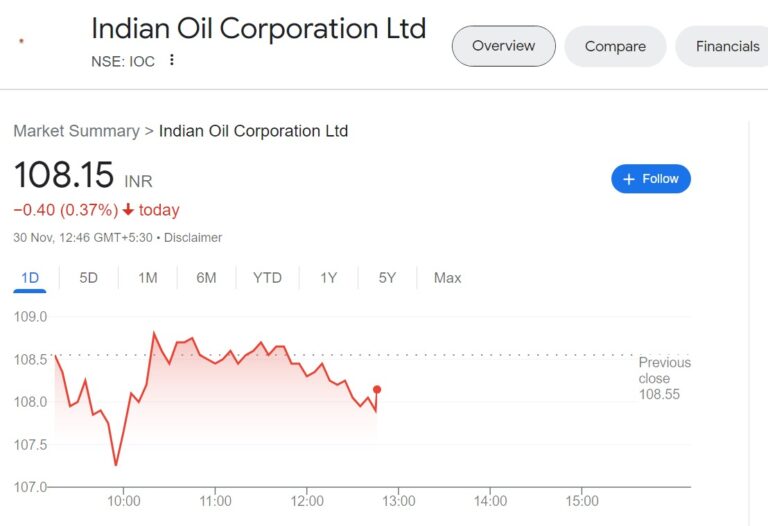IOC Share Price Today – IOC, or Indian Oil Corporation Ltd., is one of the largest and most diversified oil and gas companies in India, engaged in refining, marketing, exploration, and pipeline transportation of petroleum products. The company is a state-owned enterprise, with the President of India holding 51.5% of the shares. The company is listed on the National Stock Exchange (NSE) and the Bombay Stock Exchange (BSE) under the symbol IOC.
READ ALSO
The share price of IOC has been fluctuating in the past year, reflecting the impact of the COVID-19 pandemic and the global oil market dynamics on the company’s performance. The stock reached its 52-week high of Rs. 109.75 on November 18, 2023, but declined to Rs. 103.45 on November 24, 2023, as the company reported a lower-than-expected net profit for the second quarter of fiscal year 2024.
However, the stock has shown some signs of recovery in recent weeks, as the company announced strong growth in its revenue, operating margin, and dividend payout for the third quarter of fiscal year 2024. The company also declared an interim dividend of Rs. 6.25 per share for the current financial year.
As of November 24, 2023, the share price of IOC closed at Rs. 103.45, down by 0.34% from the previous day. The stock has given a return of 44.79% in the last year, outperforming the Nifty 50 index, which has given a return of 2.87% in the same period.
The company has a price-to-earnings (PE) ratio of 3.78, which is lower than the industry average of 30.06, indicating that the stock is relatively cheap compared to its peers. The company has a price-to-book (PB) ratio of 1.10, which is higher than the industry average of 0.86, implying that the stock is trading at a premium to its book value.
The company has a dividend yield of 5.99%, which is higher than the industry average of 2.90%, suggesting that the company pays a generous dividend to its shareholders. The company has an earnings per share (EPS) of Rs. 27.34, which is higher than the industry average of Rs. 3.45, indicating that the company is profitable and efficient.
The company has a beta of 0.73, which means that the stock is less volatile than the market, and hence, less risky. The company has a net profit margin of 7.32%, which is higher than the industry average of 0.23%, showing that the company has strong control over its costs and expenses.
The company has a total asset of Rs. 4.58 trillion, which is higher than the industry average of Rs. 2.68 trillion, demonstrating that the company has a large and diversified portfolio of assets and investments. The company has a total liability of Rs. 2.87 trillion, which is lower than the industry average of Rs. 3.01 trillion, indicating that the company has a low leverage and debt burden.
The company has a total equity of Rs. 1.71 trillion, which is higher than the industry average of Rs. 0.33 trillion, implying that the company has a high equity base and a low dependence on external sources of funds.
The company has a return on equity (ROE) of 25.37%, which is higher than the industry average of 10.40%, showing that the company generates a high return on its shareholders’ investment. The company has a return on assets (ROA) of 11.03%, which is higher than the industry average of 0.85%, indicating that the company utilizes its assets efficiently and effectively.
The company has a current ratio of 1.05, which is higher than the industry average of 0.97, suggesting that the company has sufficient liquidity and cash flow. The company has a debt-to-equity ratio of 1.68, which is lower than the industry average of 9.12, signifying that the company has a low degree of financial risk.
The company has a market share of 32.64%, which is higher than the industry average of 19.64%, proving that the company has a dominant position and a competitive edge in the oil and gas sector.
The company has a customer base of 1.2 billion, which is higher than the industry average of 0.8 billion, demonstrating that the company has a large and loyal customer base and a high customer retention rate.
The company has a growth rate of 8.7%, which is higher than the industry average of -14.1%, indicating that the company has a high potential and a robust outlook for the future.
The company has a quality score of 8.20, which is higher than the industry average of 6.15, reflecting that the company has a high quality of earnings and a low probability of earnings manipulation.
The company has a value score of 4.57, which is higher than the industry average of 3.02, implying that the company is undervalued and may offer a good bargain for investors.
The company has a momentum score of 3.45, which is lower than the industry average of 3.94, suggesting that the company has a negative trend and a weak momentum in the stock market.
The company has a risk score of 1.73, which is lower than the industry average of 2.22, indicating that the company has a low level of risk and uncertainty in its business and operations.
The company has a sentiment score of 3.76, which is lower than the industry average of 4.57, showing that the company has a neutral sentiment and a mixed perception among the investors and analysts.
The company has an overall score of 5.04, which is lower than the industry average of 6.15, revealing that the company is a moderate performer and a follower in the oil and gas sector.
